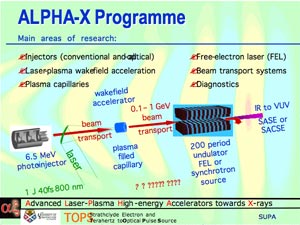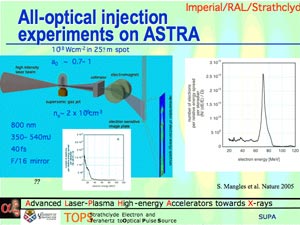The Laser Plasma Interactions Group at Strathclyde is studying the interaction of intense laser pulses with matter. There are two main laser-plasma based activities:
-
fundamental studies of laser-plasma interactions (e.g. non-linear optics of plasma), and
-
radiation and particle production (e.g. wakefield acceleration, cluster interactions, high-harmonic generation). A programme to utilise the electrons from a wakefield accelerator in a free-electron laser to produce coherent electromagnetic radiation has been set up.
In addition to access to the large laser facilities in the UK and abroad, a new Scottish femtosecond laser facility the Strathclyde Electron and Terahertz to Optical Pulse Source, TOPS, capable of intensities of more than 1019 Wcm-2, was built to support long term programmes in this area. The group collaborates with scientists at the Universities of St Andrews and Dundee.
The group has undertaken pioneering studies of superradiance, high harmonic generation, and self-amplified coherent spontaneous emission in free-electron lasers (FEL). This pioneering work paves the way to providing useful high quality x-ray pulses and it may be the only way of providing useful high quality ultra-short pulse duration pulses for time-resolved studies. These studies are being extended to i) FEL-like plasmas ii) superradiant amplification, iii) parametric processes (Raman amplification and induced transparency), iv) IR and x-ray radiation, and v) new compact methods of generating THz radiation using electron beams. Most recently, the group has observed, for the first time, quantum path interference in high harmonic spectra, and the hardest and most intense x-rays produced from rare gas clusters illuminated by intense femtosecond laser pulses.
Laser-wakefield acceleration
One of the group's larger activities is a Basic Technology Project, supported by the UK Research Councils, to develop laser plasma accelerators. This new generation of accelerators exploits the large electrostatic wakes left behind intense optical pulses traversing plasma and have gradients greater than 100 GeV/m, 3-4 orders of magnitude greater than traditional accelerator technology. They have the potential of realising a table-top GeV accelerator producing extremely bright electron beams with bunch durations of only a few femtoseconds. Such electron beams are ideal for driving compact x-ray free-electron lasers and are in themselves useful for isotope generation, pulse radiolysis and nuclear physics studies.
Alpha-X, Advanced Laser-Plasma High-energy Accelerators towards X-rays, is a programme to develop laser-plasma accelerators and apply these to producing coherent short-wavelength radiation in a free-electron laser. To realise these objectives an interdisciplinary programme involving advanced plasma, laser and electron beam physics has been set up.  The ultra-short pulses of short wavelength radiation from these compact sources have the potential of revolutionising time-resolved studies in a wide range of applications. A consortium consisting of the major laser, plasma and accelerator research groups in the UK has been created. These include groups from the University of Strathclyde, the University of Oxford, the Imperial College, the Rutherford Appleton Laboratory (CCLRC-RAL), the Daresbury Laboratory (CCLRC), the University of Dundee and the University of St. Andrews. Demonstration of the technology will take place at the University of Strathclyde.
The ultra-short pulses of short wavelength radiation from these compact sources have the potential of revolutionising time-resolved studies in a wide range of applications. A consortium consisting of the major laser, plasma and accelerator research groups in the UK has been created. These include groups from the University of Strathclyde, the University of Oxford, the Imperial College, the Rutherford Appleton Laboratory (CCLRC-RAL), the Daresbury Laboratory (CCLRC), the University of Dundee and the University of St. Andrews. Demonstration of the technology will take place at the University of Strathclyde.
 To meet the challenge of producing coherent X-rays in a FEL, a very high quality electron beam is required. The electron energy must be sufficiently high to enter the short-wavelength regime. Clearly, this is where plasma-based techniques offer a great advantage because of the high accelerating fields. The Alpha-X accelerator programme is investigating the feasibility of using plasma-based acceleration for producing ultra-short electron bunches with high charge, low energy spread, and low transverse emittance suitable for driving an FEL, or as an injector for other accelerators. A wide range of state-of-the-art diagnostic equipment is being developed to characterise the very high quality short duration electron beams expected, and to measure the plasma and FEL radiation properties.
To meet the challenge of producing coherent X-rays in a FEL, a very high quality electron beam is required. The electron energy must be sufficiently high to enter the short-wavelength regime. Clearly, this is where plasma-based techniques offer a great advantage because of the high accelerating fields. The Alpha-X accelerator programme is investigating the feasibility of using plasma-based acceleration for producing ultra-short electron bunches with high charge, low energy spread, and low transverse emittance suitable for driving an FEL, or as an injector for other accelerators. A wide range of state-of-the-art diagnostic equipment is being developed to characterise the very high quality short duration electron beams expected, and to measure the plasma and FEL radiation properties.
Laboratory scale astrophysical studies
At higher intensities extreme plasma conditions that mimic astrophysical conditions, can be created. These give rise to copious emission of hard x-rays and energetic particles, which are both of fundamental and practical interest. The extreme pressures, temperatures and intense electric and magnetic fields found in these microscopic plasmas, have the potential of being harnessed and applied to other areas of science e.g. compact electron accelerators and radiation sources. The plasma combined with high electric fields available results in relativistic effects and numerous parametric processes which have given rise to a completely new area of research: non-linear optics of plasma. These dynamic plasmas are attracting intense experimental and theoretical interest around the world. Several new cross-disciplinary projects at Strathclyde are now focussed on developing the area using table-top terawatt femtosecond lasers available at the Strathclyde Electron and Terahertz to Optical Pulse Source (TOPS). This has given rise to a new and rapidly growing community of young scientists at Strathclyde who are now pioneering the way forward in areas as diverse as compact accelerators, advanced UV and x-ray sources, terahertz sources etc. If this new area physics is developed to maturity it has the potential of revolutionising the application of x-ray radiation and particles, thus making very significant changes to the way science is carried out.
